| |
Shrine No. 17 |
last update:
02.04.2010
|
| Shrine No. |
Name /
Transliteration |
Date |
Distance to the Speos of Haremhab
[~ m] |
Remarks |
| 17 |
User-amun Wsr-Jmn |
Thutmosis III |
379 |
|
| |
|
|
|
|
| All data according to Caminos, 1963 |
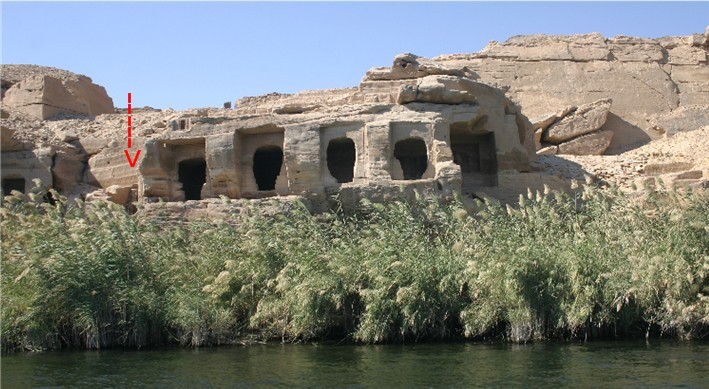
|
From right to left the shrines No.: 12 (Minnakhte), 13 (Senneferi), 14 (Nehesj),
15 (Hapuseneb), 16 (Senenmut), and - destroyed - 17 (User-amun, red arrow), all built
during the reign of Hatshepsut and Thutmosis III (photo: E. Noppes). The
entrances of all shrines were set into shallow recesses formed by cutting back
the face of the rock.
|
|
The shrine of Useramun, vizier under Thutmosis III, is much damaged. Already in
antiquity the rock above the shrine had been quarried away leaving a thin roof
which collapsed sometime. Furthermore, the statues on the rear wall had been
deliberately mutilated and the decoration of the walls had been willfully defaced. |
|
The shrine consists of one room, approx. 2 m wide and 2.35 deep. The ceiling is
more or less completely lost, but according to Caminos old drawings show that
the roof was still preserved, at least in part, in the 18th century. However,
the old drawings are contradictory as far as the form of the ceiling is
concerned. Today, only a mere vestige of its edge exists indicating that the
ceiling was about 1.5 m above the floor but these remains do not give a clue
regarding the form of the ceiling. |
|
Of the facade only small parts of the lintel and the door-jamb have been
preserved on the the northern (right) side of the door-way. The following photo
shows the actual situation. |
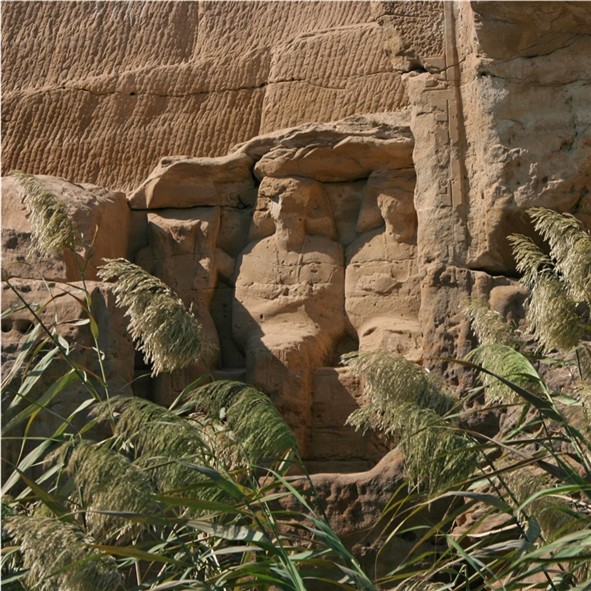
 |
|
The left drawing taken from Caminos shows what has been preserved on the
northern (left) inner side of the east wall. On the lower part of the panel
the figure of Useramun who was depicted most likely with raised hands in a
posture of adoration has been completely hacked out. The accompanying text reads:
"Giving praise [to Amun, kissing the ground ?] before
the lord of the gods, lord of life, always given [praise by ?] the
hereditary prince and count, overseer of the city and vizier, Useramun". |
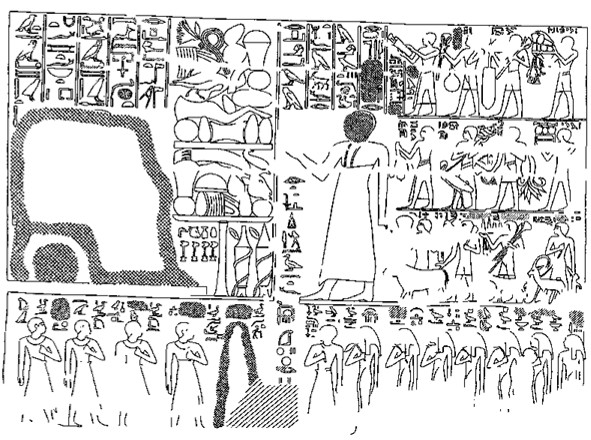
|
The north wall is decorated in two registers which both stretch the full length
of the wall. The upper registers shows on the
west (left) side 2 persons seated before piled offerings. Both figures and their
chair had been carefully chiseled out. However, the accompanying text identifies
the persons as the parents of Useramun, the vizier Amose (= Ametju) and his beloved wife, the lady of the house,
Tj-Ametju. |
|
Opposite to them, in the middle of the wall, a man clad in a long-skirted
garment is depicted obviously raising the right hand to consecrate the
offerings. The text identifies the man as the vizier User-amun the owner of the
shrine whose face was deliberately destroyed. User-amun is, like a priest,
performing the funeral rite for his parents. |
Behind User-amun, arranged in three registers, 12 men are shown bringing various
offerings. With one exception the accompanying inscriptions identifies
each man with his name.
Top row, from left:
1. Steward of the vizier Amenemhat (owner of TT 82)
2. ... Amenmose
3. Herald of the vizier Bak
4. Butler Ipunufer
2nd row, from left:
5. Steward and scribe (Ahmose-)Hamashu
6. Herald 'Ahmose
7. Butler Ki
8. Butler Harwadje
3rd row, from left:
9. Nesneferhotep
10. sculptor 'Opahte
11. ..... name lost
12. draughtsman A[men]emwaskhet
|
|
The complete lower register shows several persons, in most cases relatives. In
the western (left) half of the register five sons of Ametju are depicted
standing and facing east, from right to left: Amenemhet, Neferhotep, Neferuben,
Nakht[amun], and Hor. |
|
Opposite and facing west the register shows a man followed by 6 women, from left
to right: Tjuro (= Turj; perhaps a relative by marriage), the daughters of
Amethu Ahmose, Ahhotep,
Sentyhotep, his daughters-in-law [Tj]uiu, Bakt, a 2nd Bakt, and a woman named
Iot whose relationship is lost due to the destruction of the shrine.. |
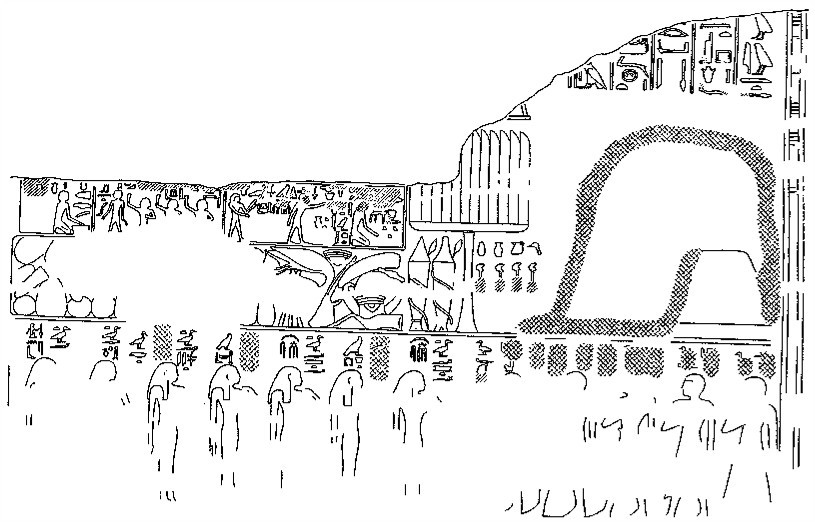
|
The south wall of the shrine (see drawing of Caminos above) is more destroyed
than th north wall, the upper part is completely missing, and the preserved part
is in a very poor state. As the north wall the south wall had been decorated in
two registers and carved in low relief. |
|
The upper register shows on its west side (right) 2 figures sitting before a
table with offerings. The figures and their chair had been carefully erased but
the partly preserved text above identifies them definitely as User-amun and his
beloved wife [Tj]uiu. |
|
Left of the table of offerings the upper register had been divided into three
smaller registers. The upper row of scenes is completely lost, Caminos assumes
that a list of offerings had been carved there. The middle row shows several
priests performing different parts of the funerary rite. The lower row presents
numerous offerings. |
|
The lower register extending across the south wall presents the children of User-amun
and [Tj]uiu. Five sons are standing on the west (right) side facing east to
their 7 sisters. All children had been identified by their names but not all
have been preserved. Only the name of the 4th son has survived: [Mery]amun. The
7 daughters were: Ahmose, [Amen]-emwaskhet,
Ahmose, [Amen]emhab, Bakt, Henet, und Sensoneb. |
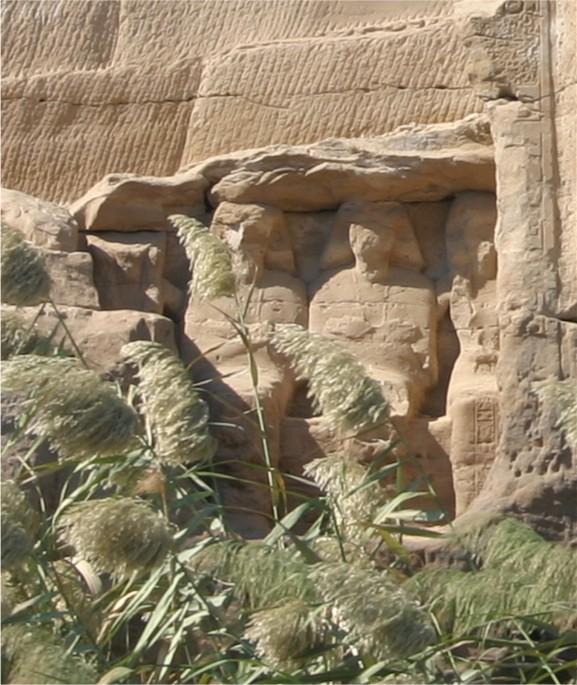
|
The rear wall of the shrine is fully occupied be 4 seated statues (see photo
above). The statues represent two men sitting in the center and two women seated
on the outer sides, all of them are badly damaged. The woman on the northern
(right) is shown with her left arm bent and resting on her belly, the right arm
embraces her husband. The 3rd figure is another man who is embraced by his wife
seated far left. Both men are shown crossing their arms on their chests. |
|
All four statues bear inscriptions on the lap and the legs. All inscriptions are
badly damaged but enough has survived to identify the statues, from right to
left: Ti-Amehtiu, her husband Amethiu, their son User-amun, and their
daughter-in-law, [Tj]uiu. |
|





